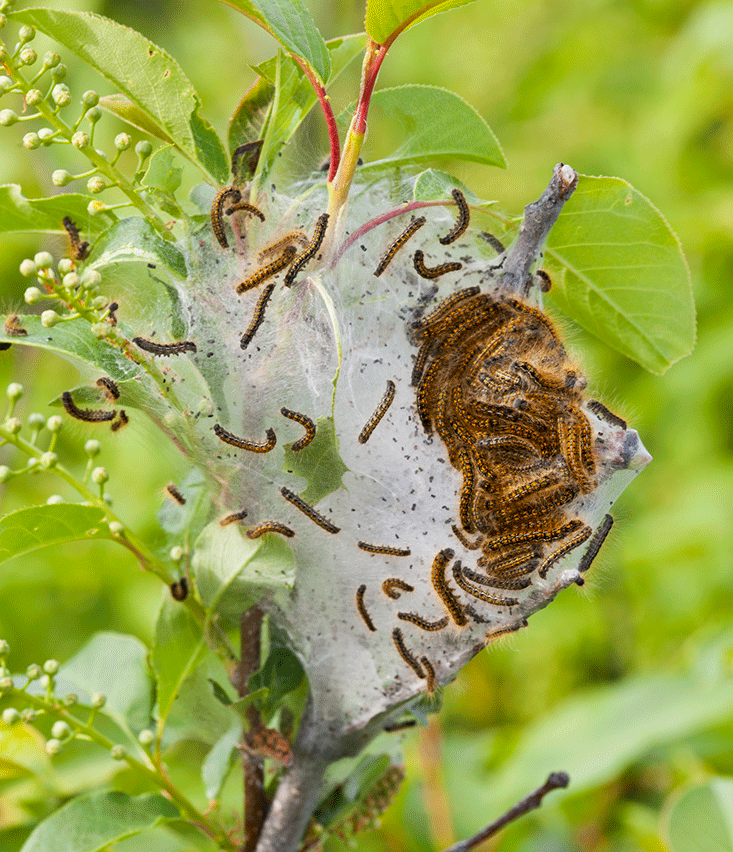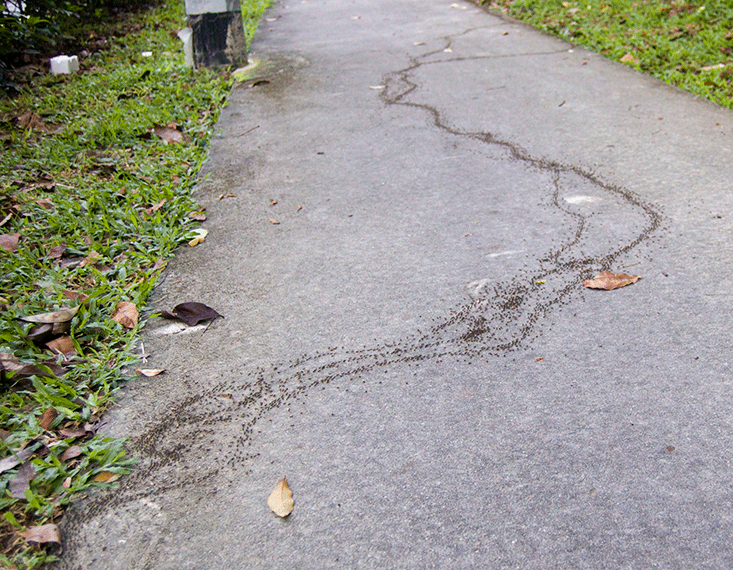The story of how we grew wise to the wisdom of insect trails begins, oddly enough, with the lowly caterpillar. One spring day in 1738, a young Genevan philosophy student named Charles Bonnet, while walking through the countryside near his family’s home in Thônex, found a small, white, silken nest strung up in the branches of a hawthorn tree. Inside of the nest were squirms of newly hatched tent caterpillars, which bristled with fiery red hairs.
At just 18 years old, frail, asthmatic, myopic, and hard of hearing, Bonnet was a somewhat unlikely naturalist. But he was blessed with patience, attentiveness, and a relentless, burning curiosity. As he approached the cusp of adulthood, his father had begun pressuring him to become a lawyer, but he wanted to spend his life exploring the microcosmos of insects and other tiny creatures, a profession that had scarcely yet been invented.
Bonnet decided to cut down the hawthorn branch and carry it back home. At the time, most naturalists would have sealed the caterpillars in a powder jar, called a poudrier, to better inspect their anatomy. But Bonnet wanted to observe the caterpillars’ natural behavior wholly unobstructed, en pleine aire, from the comfort of his home. He struck upon the idea of mounting the hawthorn branch outside the window-frame of his study. That window soon became a kind of antique television, a glass screen displaying a miniaturized world, before which he spent countless rapt hours.

After two days of patiently waiting for signs of life, Bonnet watched the caterpillars emerge from their nest and begin to march in single file up the windowpane. After four hours, the procession had successfully scaled the window, then it turned around. In descending, strangely, the caterpillars followed the exact path they had climbed. Bonnet later wrote that he even traced their route—presumably, with a wax pencil upon the windowpane—to see if they ever deviated from it. “But they always followed it, faithfully,” he wrote.
Each day Bonnet watched as the caterpillars mounted exploratory expeditions across the windowpane. Paying closer attention, he noticed that as they crawled, each caterpillar laid down an ultra-fine white thread, which the others followed. Curious, Bonnet rubbed his finger across their trail, breaking the thread. When the leader of the returning party arrived at the rupture, it turned back, apparently confused. The one behind it did the same, and the one behind that. Each subsequent caterpillar plodded calmly along until it reached the gap in the trail, at which point it either turned around or stopped to feel about for the thread, like a man groping for a dropped flashlight. Finally, one of the caterpillars, which Bonnet deemed “hardier than the others,” dared to venture forward: A thread was extended across the void, and the others followed.
Emboldened, Bonnet collected more caterpillar nests, which he placed on his mantle. Soon, scores of caterpillars were exploring his bedroom, meandering across the walls, the floor, even the furniture. Feeling, no doubt, like a small new god, Bonnet found he could control where the caterpillars traveled simply by erasing certain trails. He delighted in showing this trick to visitors. “You see these little caterpillars who walk in such good order?” he would ask. “Well, I bet you that they will not pass beyond this mark”—and he would swipe his finger across their route, stopping them cold.
One year after his initial caterpillar experiments, Charles Bonnet was outside hunting for a new batch of caterpillars when he happened across a prickly flower, called a teasel, whose head harbored a colony of tiny red ants. Ever curious, he plucked the flower, carried it back to his study, and planted it upright in an open powder jar.
One day, Bonnet returned to discover that a number of the ants had deserted the nest. Searching about, he found them marching up his wall to nibble the wood at the top of his window frame. In his journal, Bonnet described watching one ant as it climbed down the wall, up the side of the powder jar, and back to the nest. At the same time, two ants emerged from the teasel-head and climbed to the top of the window-frame, following precisely the same route that the other had just descended.
“Instantly, it came to my mind that these ants which I had in front of me, like the caterpillars, left a trace that directed them in their course,” he recalled.
Of course, he knew that ants did not emit a thread. But they did give off a strong smell, which is sometimes described as being reminiscent of urine. (This odor lent ants their archaic name, “pismires,” and later, “piss-ants.”) The substance, Bonnet theorized, could “more or less adhere to objects they touch, and then act on their sense of smell.” He compared those “invisible traces” with the trails of wildcats, which are imperceptible to humans but plain as blood to dogs.
His suspicion was easily tested: As before, he rubbed his finger across the ants’ pathway. “Doing so, I broke the path on a width equal to that of my finger, and I saw precisely the same spectacle the caterpillars had given me: The ants were diverted, their walk was interrupted, and their confusion amused me for me some time.”
Bonnet had stumbled upon an elegant explanation for how ant trails form, which required neither powerful memories, strong eyesight, or simple language. Bonnet theorized, correctly, that ants ordinarily follow trails that lead to their homes and to food sources. However, some ants wander off-track, “attracted by certain smells or other sensations to us unknown,” spawning new side-roads. If that rogue ant finds food, it will leave a new trail on its return to the nest, and other ants will follow. So, wrote Bonnet, “a single ant can lead a large number of its companions to a certain place without any need of a particular language whereby it announces the discovery that it has just made.”

Judging from his journals, Bonnet seems not to have realized how historic this discovery was. Scientists had long suspected that ants deposit chemicals when they walk; in the 15th century, two German botanists, Otto Brunfels and Hieronymus Bock, discovered that ants produce formic acid after noticing that a blue chicory flower, when thrown into an anthill, turns a vivid red. But no one properly connected the dots until Bonnet.
In the late 1950s, E.O. Wilson located the gland in fire ants that secretes trail pheromones, and in the 1970s, a biologist named Terrence D. Fitzgerald, being familiar with Wilson’s work, discovered that tent caterpillars use trail pheromones. It may seem odd, then, that neither Wilson nor Fitzgerald cites Bonnet’s discovery. In fact, many of Bonnet’s writings, including the story of how he discovered the true nature of ant trails, have never been published in English. Bonnet’s lack of renown as an entomologist may be due to the fact that, though his career showed a promising start, it ultimately veered off on an ill-fated path.
By his late 20s, Bonnet was already a celebrated naturalist: the first person to witness a virgin birth among plant lice, the first to describe regeneration among worms, the first to learn that caterpillars breathe through holes in their skin, and the first to prove that leaves exhale. Then, in a cruel twist, his vision began to cloud with cataracts. Unable to practice observational science, he turned to more cerebral fields, like philosophy, psychology, metaphysics, and theology. Much of the latter half of his life was spent trying to reconcile the confusing new findings of the biological sciences with his deep religious faith, which held that the world was divinely engineered. Bonnet’s magnum opus—an all-encompassing theory of the universe called the “Great Chain of Being,” which posited that all species were slowly progressing toward a state of perfection over the course of eons—had some influence on later evolutionary theorists like Jean-Baptiste Lamarck and Georges Cuvier. But in the broader span of scientific progress, it proved little more than a theoretical side-road, which was later made obsolete by Darwin’s theory of evolution by natural selection.
By the end of his life, Bonnet’s blindness caused him to suffer from phantasmagoric visual hallucinations, which are now known as Charles Bonnet Syndrome. Oddly enough, Charles Bonnet Syndrome is so named not because Bonnet suffered from it, but because he was the first person to describe it: His grandfather, Charles Lullin, had suffered from it decades earlier, and Bonnet wrote a case study about him. The fact that Bonnet later acquired the syndrome as well was merely an unhappy coincidence. Today, that syndrome is primarily what he is remembered for, when he is remembered at all.
Robert Moor has written for Harper’s, n + 1, New York, and GQ, among other publications. A recipient of the Middlebury Fellowship in Environmental Journalism, he has won multiple awards for his nonfiction writing.
From On Trails: An Exploration by Robert Moor. Copyright © 2016 by Robert Moor. Reprinted by permission of Simon & Schuster, Inc.


























